We have tackled courtesy and defensive driving on the road with regard to regular cars and small trucks and SUVs, but we should discuss the additional challenge of driving on the same roads with the very small or the very large; Motorcycles, Recreational Vehicles (RV) and small and large commercial trucks.
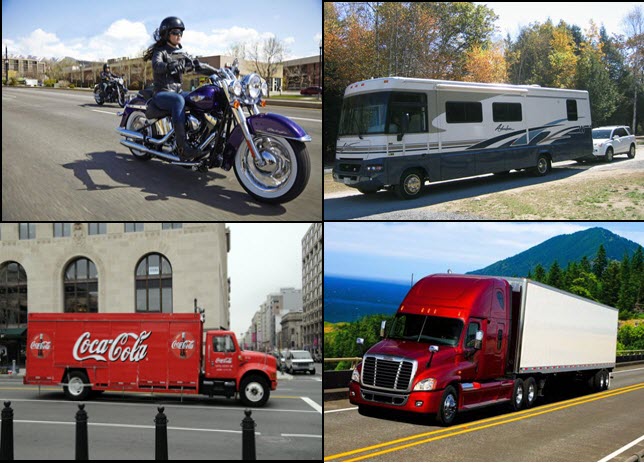
Let’s review some tactics to drive defensively — and courteously — around them.
Motorcycles
Two-thirds of motorcycle crashes involve a car, and are most often the fault of the car driver.
These crashes are due to the fact that the driver either fails entirely to see the motorcycle driver, or sees him/her too late. This is often due to the fact that as drivers, we are not tuned in to looking for smaller vehicles such as motorcycles and motor scooters.
As a SmartDriver you must be diligent in checking and double checking for smaller vehicles, listening attentively to their unique sound and adjusting to their presence.
Motorcycle riding is different from driving, reacting on two wheels is far different than on four. The elements have a dramatically more profound impact on bikes than on cars.
This video, created by the Washington Motorcycle Safety Program, follows a teen driver as a motorcyclist helps the driver learn about safer choices while sharing the road with motorcyclists.
CREDIT: Washington State Department of Licensing, Motorcycle Awareness — A Second Look
How Can I Become More Aware of Motorcyclists?
- Respect the motorcyclist: Remember the motorcycle is a vehicle with all of the privileges of any vehicle on the roadway. Give the motorcyclist a full lane of travel.
- Look out: Look for the motorcyclist at intersections, when a motorcyclist may be making a left turn, and on the highway, when a motorcyclist may be changing lanes. Clearly signal your intentions.
- Anticipate a motorcyclist’s maneuver: Obstructions that you do not notice may be deadly for a motorcyclist. Predict evasive actions.
- Allow plenty of space: Don’t follow a motorcycle too closely. Allow enough room for the motorcyclist to take evasive actions.
What Are Some Situations When Crashes Are Most Likely to Occur?
- Car making a left turn: You are attempting a left turn in front of an oncoming motorcycle operator.
- Riding in your blind spot: A motorcyclist is riding in your blind spot and you may not see the motorcycle. Additionally, you may fail to adequately check blind spots before changing lanes or making turn.
- Hazardous road conditions: Potholes, wet leaves, railroad tracks and other road obstructions may dictate that a motorcyclist take an action that you may or may not.
- Obstructed line of sight: Large vehicles, such as sport utility vehicles, delivery vans, and large trucks may block a motorcycle from your view and the motorcyclist may seem to suddenly appear.
As the “Save A Biker” website says, “Look twice, save a life.”
How to drive defensively around trucks and RVs:
While many trucks and RVs seem almost the same size, there is one very important difference.
- In most cases, truck drivers are very experienced professionals who understand the importance of road awareness and safety;
- However, more often than not in the case of RV operators, they have much less experience behind the wheel of their vehicles, and they increase risks by towing cars or trailers behind their vehicles.
So remember these tips:
- Do Not cut off a truck or RV in traffic or on the highway to reach your exit or turn and Do Not try to beat them into a single lane construction zone. Both of these situations can easily turn into crash situations.
- Do Not linger alongside a truck or RV when passing. These vehicles both have large blind-spot areas: pass them completely, at a steady pace, and on the LEFT side.
- Do Not rush ahead on the right side of the vehicle, as these vehicles make wide right turns… If it appears they are about to turn left, remember it may be actually making a right turn and you will be caught in the NO ZONE.
- Do Not follow too closely or tailgate, as it will deny you escape routes and the ability to react to roadway hazards that may lie ahead.
CREDIT: Driver Solutions, 10 Tips for Sharing the Road with Truck Drivers
Remember too, the stopping distance for a much larger and heavier vehicle is in some cases TWICE that of a car.
• Passenger cars have a stopping distance of 193 feet on dry, level payment.
• RVs and fully loaded semi trucks have a stopping distances of 243 feet to 430 feet.
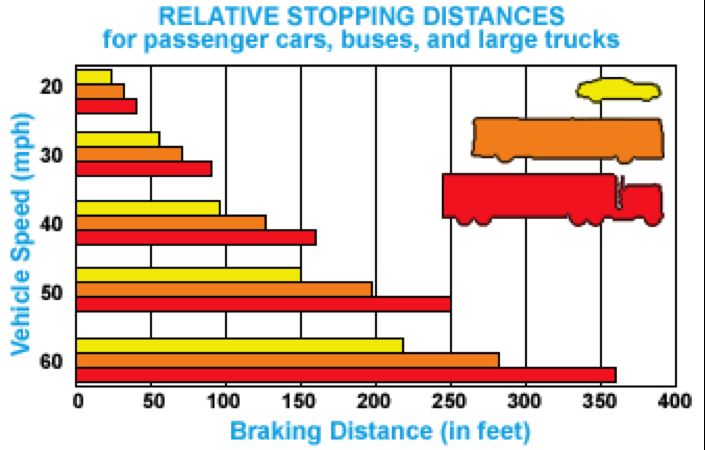
CREDIT: Truck It Smart, Relative Stopping Distance
While you may not see them too often in the U.S. Eastern Seaboard traffic corridors, many states now allow double and even triple semi-tractor and trailer combinations on their Interstate and Primary highway systems.
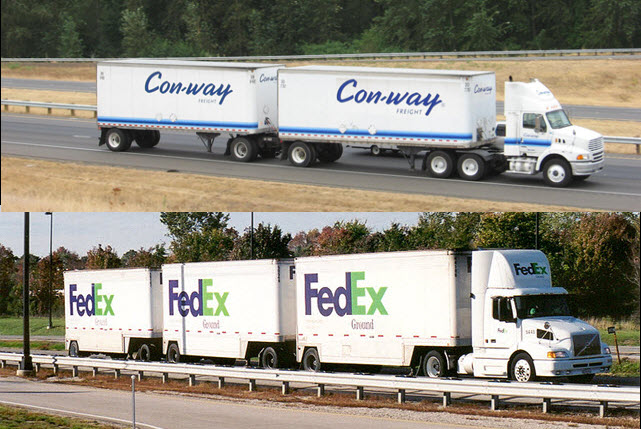
If you do not drive often on Interstates and other Primary Highways, what you may encounter local streets on a regular basis are delivery trucks servicing homes and stores, and gasoline tankers making deliveries to gas stations and convenience stores.
Delivery trucks may make what seem to you to be sudden turns and stops, and you must be alert for those maneuvers.
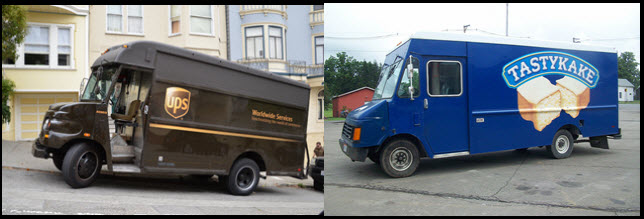
Gasoline tankers are large vehicles often trying to squeeze into small spaces to deliver their products, and, of course, the gasoline, diesel and kerosene products they deliver are hazardous and highly flammable.
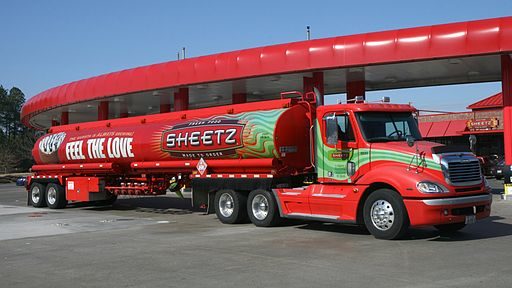
In every case, being an alert and aware SmartDriver will keep you and your passengers safe around these large vehicles.
BICYCLES AND BICYCLISTS
As cyclists sometimes like to remind drivers, there were bicycles on Delaware’s public roads before motor vehicles were ever invented and even though the amount of motor vehicle traffic on the roads has since exploded cyclists retain their legal right to use public roadways despite the growth of vehicle traffic. In fact, cyclists have the right to use all Delaware roads except limited access highways.
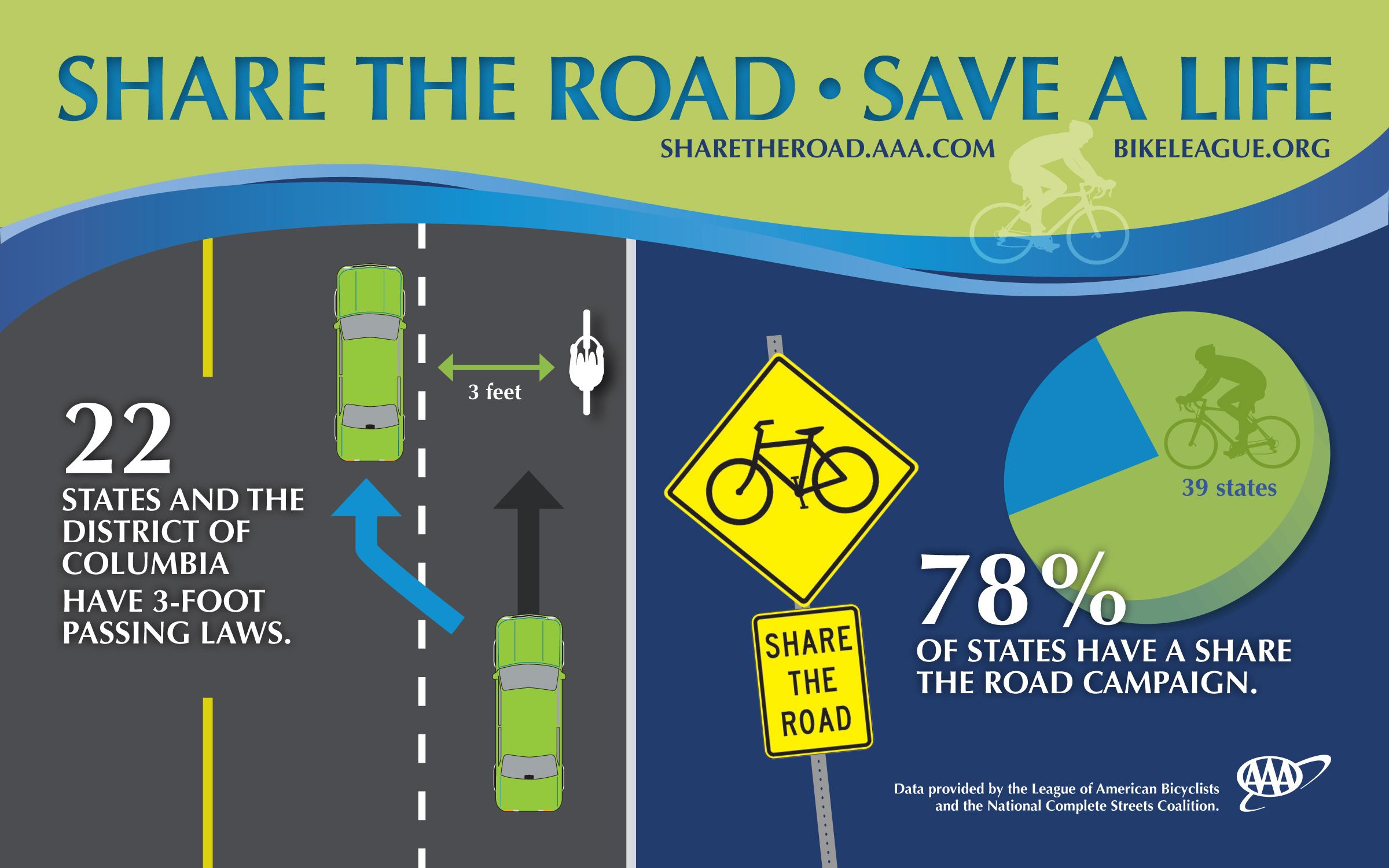
Infographic on bike safety and sharing the road with automobiles.
CREDIT: AAA Foundation
Bicycle Friendly Delaware Act
- This law requires drivers to change lanes (including when there is a double yellow line) when passing bicycles if the travel lanes are too narrow for sharing. Motorists must give bicyclists at least three (3) feet of room when passing.
- Motorists are forbidden from honking their horn at bicyclists unless there is an imminent danger.
- Bicyclists should ride to the right of the roadway as their safety allows.
- Bicyclists are now allowed to yield at stop signs, after carefully looking for other vehicles and no longer required to stop.
Your Responsibility As A Driver
When you are driving at slower speeds on local streets, you can safely and legally interact with bicycles much as you would with other vehicles. When you are driving at higher speeds, however, the air pressure created by your vehicle passing too closely (particularly if you are driving a truck or a bus) can cause a cyclist to crash.
In order to pass a bicycle safely, the law in Delaware requires that you completely change lanes, including crossing a double-yellow center line, if the travel lane you are traveling in is too narrow for the vehicle you are driving and the bicycle you want to pass to travel safely side by side within the lane. In the unusual case of very wide travel lanes (wide enough for both your vehicle and a bicycle), the law permits you to pass a bicycle without changing lanes but requires that you (a) slow down when doing so and (b) leave a minimum of three feet of clearance at all times between your vehicle and the bicycle.
CREDIT: How to Safely Share the Road with Cyclists | Allstate Insurance
If the road you are driving on has only two lanes and you are unable to pass safely because of lack of visibility and/or oncoming traffic, follow at a safe distance and wait until it is safe before passing. Allow plenty of clearance after overtaking a cyclist, before you pull to the right. The cyclist’s speed may be greater than you realize. It is illegal to blow your horn at a cyclist except in the very narrow circumstance when you are warning the cyclist of an imminent collision.
Many car/cycle crashes occur because the motorist does not see the cyclist. Be especially careful to look for cyclists when you are preparing to enter a roadway or to make a turn. Intersections are particularly dangerous for both cars and cycles. Make sure that there is sufficient time before turning left or right. Don’t pass a cyclist only to turn directly in front of him/her. When in doubt, wait. At night, be aware that bicycles can be harder to see.
AN IMPORTANT REMINDER
A BICYCLIST PUSHING THEIR BIKE ON ROADWAY IS TO BE TREATED AS A PEDESTRIAN – giving them the same rights and responsibilities as any other pedestrian.
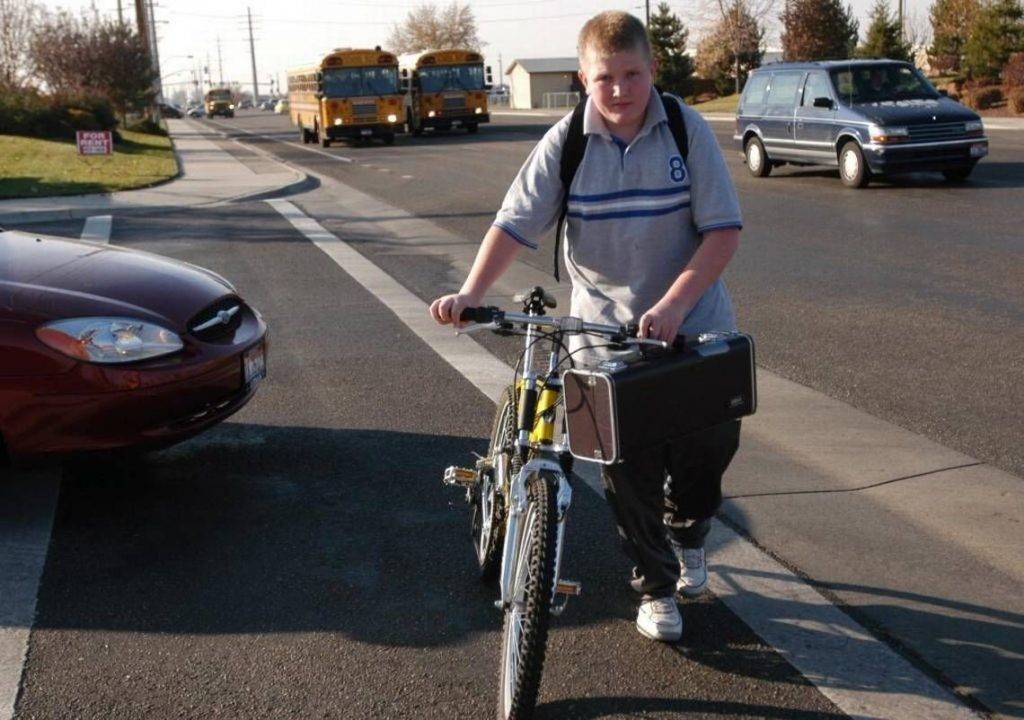
CREDIT: General Public License
On the subject of PEDESTRIANS –
In 2022 alone, there were 33 pedestrian and 7 bicyclist fatalities in Delaware. Fatalities are often the result of pedestrians who are not wearing reflective clothing or carrying a light while walking at night, not crossing the road within a designated crosswalk and/or are under the influence of alcohol.
Please Note: It is imperative to be aware of your surroundings as a driver and stop if a pedestrian is actively crossing in a marked or unmarked crosswalk. You may proceed with caution if a pedestrian is standing/stopped safely on the sidewalk as required by law.
Your Responsibility for Pedestrians As A Driver
- Be alert for pedestrians walking along or crossing the road; lightly tap horn if necessary. Sounding the horn is not considered a substitute for yielding to pedestrians.
- Drivers should be alert for individuals and must yield the right-of-way to pedestrians who are hearing impaired or have physical disabilities that require use of canes, crutches, walkers, guide dogs/service animals, wheelchairs, or motorized scooters. These individuals may have difficulty detecting oncoming traffic and may need extra time to cross the road.
- You must not drive through a pedestrian safety zone or block a crosswalk.
- You must yield the right-of-way to any pedestrian within a crosswalk, stopping if necessary.
- You must not pass a vehicle stopped to allow a pedestrian to cross the highway.
- You should be especially watchful for children near schools and in residential districts. Do not speed in school zones.
- You must always stop before reaching a school bus when it is stopped to load or unload school children, except when you are on the opposite side of a divided highway having four or more lanes.
- You should look carefully for traffic before leaving your vehicle.
- Drive defensively at all times.
CREDIT: ‘Close Call’: Pedestrian Safety for Young Drivers – Pennsylvania Department of Transportation
